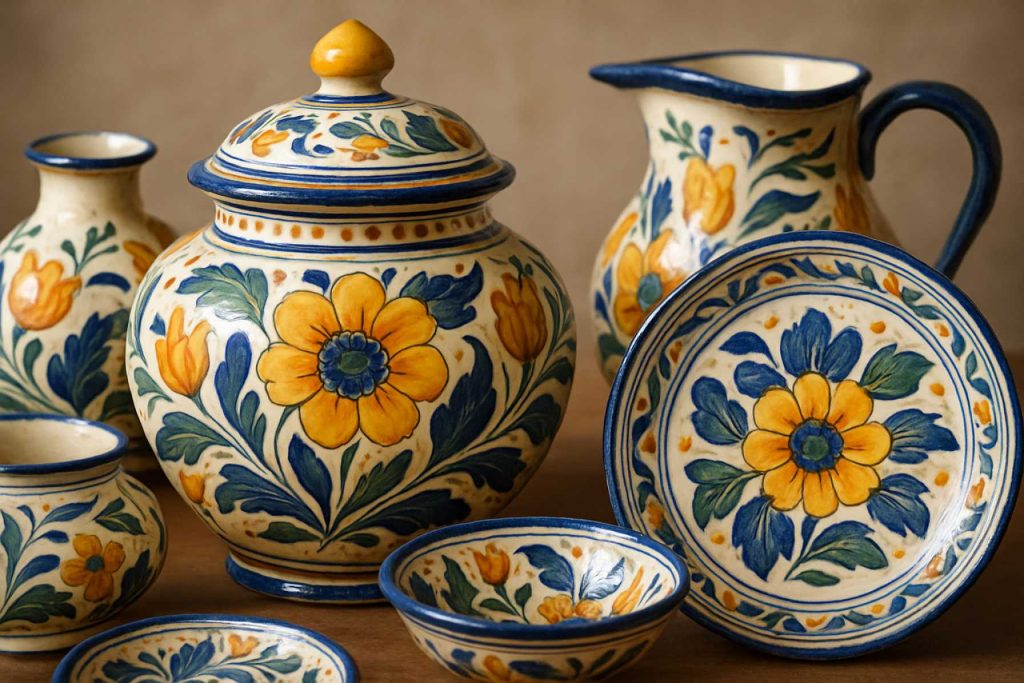
Discover the Timeless Allure of Fajance Pottery: Exploring Its Colorful History, Techniques, and Enduring Influence on Ceramic Art. Dive Deep into the World of Glazed Earthenware That Captivated Generations.
- Origins and Early Development of Fajance Pottery
- Distinctive Materials and Glazing Techniques
- Iconic Styles and Regional Variations
- Symbolism and Decorative Motifs in Fajance
- Fajance in European Art and Society
- Master Artisans and Influential Workshops
- Collecting and Authenticating Fajance Pieces
- Conservation Challenges and Restoration Methods
- Fajance Pottery in Contemporary Design
- Future Trends and the Revival of Fajance Craftsmanship
- Sources & References
Origins and Early Development of Fajance Pottery
Fajance pottery, also known as faience, traces its origins to ancient civilizations, where artisans developed innovative techniques to create brightly colored, tin-glazed earthenware. The term “faience” is derived from the Italian city of Faenza, a renowned center for the production of this type of pottery during the Renaissance. However, the roots of faience extend much further back, with early examples found in ancient Egypt, Mesopotamia, and the Mediterranean basin. Egyptian faience, dating as far back as 4000 BCE, was not true pottery but rather a non-clay ceramic material made from ground quartz, coated with a vitreous glaze that produced a lustrous, blue-green surface. This material was used for amulets, tiles, and small vessels, reflecting both technological innovation and symbolic significance in ancient Egyptian culture (British Museum).
The development of tin-glazed earthenware, which is more closely related to what is now called fajance, began in the Islamic world around the 9th century CE. Artisans in Iraq and Persia pioneered the use of a white, opaque glaze made by adding tin oxide to lead glaze, which allowed for the application of vibrant painted designs. This technology spread westward across North Africa and into Spain, where it became known as “majolica,” and later into Italy and the rest of Europe. By the 15th and 16th centuries, the city of Faenza in northern Italy had become a major center for the production of high-quality tin-glazed pottery, giving rise to the term “faience” in French and “fajance” in other European languages (Victoria and Albert Museum).
In Northern Europe, particularly in the Netherlands and Germany, the technique was further refined during the 16th and 17th centuries. Dutch potters in Delft became especially famous for their blue-and-white faience, known as Delftware, which was inspired by imported Chinese porcelain. The spread of fajance pottery throughout Europe was facilitated by trade, migration of skilled artisans, and the growing demand for decorative and functional ceramics among the emerging middle classes. The adaptability of the tin-glaze technique allowed for a wide range of artistic expression, from intricate narrative scenes to bold geometric patterns, making fajance a significant chapter in the history of ceramic art (Rijksmuseum).
Distinctive Materials and Glazing Techniques
Fajance pottery is renowned for its distinctive materials and glazing techniques, which set it apart from other ceramic traditions. The term “fajance” (or “faience”) refers to a type of tin-glazed earthenware that originated in the Middle East and later flourished in Europe, particularly in countries such as Italy, France, Germany, and Denmark. The hallmark of fajance pottery lies in its use of a porous, low-fired clay body, typically made from local earthenware clays. This clay is fired at relatively low temperatures, resulting in a soft, absorbent base that is ideal for the application of glazes and painted decoration.
The most distinctive feature of fajance pottery is its tin-glazed surface. Artisans apply a glaze made by suspending tin oxide in a lead glaze, which, when fired, produces a brilliant, opaque white surface. This white background serves as an ideal canvas for colorful, hand-painted designs. The tin-glazing process not only enhances the visual appeal of the pottery but also provides a protective, water-resistant layer, making the wares both decorative and functional. The technique was first developed by Islamic potters in the 9th century and later spread to Europe, where it became central to the production of majolica in Italy, faïence in France, and delftware in the Netherlands and England.
In addition to tin oxide, other materials such as lead oxide, silica, and various metal oxides are used to create a range of colored glazes. Cobalt oxide, for example, produces deep blue hues, while copper oxide yields greens and manganese oxide results in purples and browns. The application of these colored glazes is often done by hand, using brushes to create intricate patterns, floral motifs, or figurative scenes. The painted designs are then covered with a transparent overglaze and fired again, fusing the decoration to the surface and enhancing its durability.
The technical mastery required for successful tin-glazing and decoration is significant, as the absorbent clay body and the fluidity of the glaze demand precise control during both application and firing. Institutions such as the Victoria and Albert Museum and the British Museum house extensive collections of fajance pottery, showcasing the diversity of materials and techniques employed across different regions and periods. These collections highlight the enduring appeal and technical sophistication of fajance pottery, which continues to inspire contemporary ceramic artists and collectors worldwide.
Iconic Styles and Regional Variations
Fajance pottery, a distinctive form of tin-glazed earthenware, is celebrated for its vibrant colors, intricate designs, and regional diversity. Originating in the late Middle Ages, the term “fajance” is derived from Faenza, Italy, a city renowned for its high-quality ceramics. Over centuries, the craft spread across Europe, with each region developing its own iconic styles and decorative traditions.
In Italy, particularly in Faenza, fajance pottery is characterized by its white, opaque glaze and elaborate polychrome decoration, often featuring floral motifs, mythological scenes, and geometric patterns. The Italian maiolica tradition, closely related to fajance, set the standard for artistic excellence and technical innovation in tin-glazed ceramics. The influence of Italian fajance extended to France, where it became known as “faïence.” French centers such as Nevers, Rouen, and Moustiers developed their own distinctive styles, with Rouen faïence recognized for its blue and white palette and intricate lambrequin (scalloped) borders, while Moustiers became famous for its delicate, Rococo-inspired motifs.
In the Netherlands, the city of Delft emerged as a major center for fajance production in the 17th century. Delftware, as Dutch fajance is commonly known, is instantly recognizable by its blue and white decoration, inspired by imported Chinese porcelain. Dutch potters adapted these motifs to local tastes, producing a wide range of items from tiles to plates and vases. The enduring legacy of Delftware is maintained today by institutions such as the Royal Delft factory, which continues to produce hand-painted ceramics using traditional methods.
Germany also developed a strong fajance tradition, particularly in the regions of Hanau, Frankfurt, and Hamburg. German fajance is noted for its robust forms and a palette that expanded beyond blue and white to include vibrant yellows, greens, and purples. Scandinavian countries, especially Denmark, embraced fajance in the 18th and 19th centuries. Danish fajance, produced by companies like Royal Copenhagen, is known for its refined shapes and subtle, often nature-inspired decoration.
Each regional variation of fajance pottery reflects local tastes, available materials, and cultural influences, resulting in a rich tapestry of styles. From the ornate Italian maiolica to the restrained elegance of Danish fajance, these ceramics continue to captivate collectors and historians, underscoring the enduring appeal and adaptability of tin-glazed earthenware across Europe.
Symbolism and Decorative Motifs in Fajance
Fajance pottery, renowned for its tin-glazed earthenware, is distinguished not only by its technical innovation but also by its rich symbolic language and decorative motifs. Originating in the Middle East and flourishing in Europe from the Renaissance onward, fajance became a canvas for artistic expression, reflecting cultural, religious, and social themes through its ornamentation.
The decorative motifs on fajance pottery are deeply rooted in the traditions and beliefs of the regions where it was produced. In Islamic lands, where the technique first developed, geometric patterns, arabesques, and calligraphic inscriptions dominated, reflecting religious prohibitions against figurative imagery and a reverence for mathematical harmony. These motifs often symbolized infinity, unity, and the divine order of the universe. As the technique spread to Italy, Spain, and the Netherlands, local artisans adapted the motifs to suit their own cultural narratives. Italian maiolica, a form of fajance, frequently featured mythological scenes, heraldic emblems, and botanical motifs, symbolizing power, lineage, and the bounty of nature.
In the Netherlands, Delftware—a celebrated type of Dutch fajance—became famous for its blue-and-white palette and intricate scenes. These often depicted landscapes, maritime adventures, and daily life, serving both decorative and documentary purposes. The use of chinoiserie motifs, inspired by imported Chinese porcelain, symbolized global trade connections and the allure of the exotic. Floral patterns, such as tulips and peonies, were not only decorative but also carried meanings of prosperity and beauty, reflecting the Dutch Golden Age’s fascination with horticulture and natural science.
Religious symbolism was also prevalent, especially in Spanish and Portuguese azulejos (tin-glazed tiles), where Christian iconography, saints, and biblical narratives adorned churches and public buildings. These motifs served didactic purposes, conveying moral lessons and reinforcing communal identity. In Scandinavia, particularly Denmark, fajance produced by companies like Royal Copenhagen incorporated Nordic folklore, stylized animals, and seasonal motifs, symbolizing local heritage and the rhythms of rural life.
The enduring appeal of fajance motifs lies in their ability to blend aesthetic beauty with layers of meaning. Whether through the repetition of geometric forms, the depiction of mythological tales, or the celebration of local flora and fauna, fajance pottery remains a testament to the universal human desire to communicate, commemorate, and beautify everyday objects. Today, museums and cultural institutions continue to preserve and study these motifs, recognizing their significance in the broader history of art and design.
Fajance in European Art and Society
Fajance pottery, a type of tin-glazed earthenware, has played a significant role in European art and society since its introduction in the late Middle Ages. The term “fajance” derives from Faenza, an Italian city renowned for its high-quality ceramics, but the technique spread rapidly across Europe, influencing artistic traditions and daily life in numerous countries. Characterized by its opaque white glaze and vibrant painted decoration, fajance became a popular medium for both utilitarian and decorative objects, including plates, tiles, vases, and figurines.
In the 16th and 17th centuries, the production of fajance flourished in Italy, Spain, France, the Netherlands, and Germany. Each region developed its own distinctive styles and motifs, often reflecting local tastes and cultural influences. For example, Dutch Delftware, produced in the city of Delft, became famous for its blue-and-white designs inspired by imported Chinese porcelain. Similarly, French faïence centers such as Rouen, Nevers, and Moustiers contributed unique patterns and color palettes, often incorporating Rococo and Baroque elements. These regional variations not only enriched the visual language of European ceramics but also fostered a sense of local identity and pride.
Fajance pottery was more than just an artistic expression; it played a vital role in the social and economic fabric of European communities. The accessibility of earthenware, compared to more expensive porcelain, made fajance a staple in households of varying social classes. Its decorative appeal also made it a favored choice for tableware, religious objects, and architectural ornamentation. The widespread use of fajance in domestic and public spaces reflected changing attitudes toward material culture and the growing importance of aesthetics in everyday life.
Major museums and cultural institutions across Europe, such as the Victoria and Albert Museum in London and the Musée du Louvre in Paris, house extensive collections of fajance pottery, underscoring its enduring artistic and historical significance. These collections provide valuable insights into the technological innovations, trade networks, and cross-cultural exchanges that shaped European society from the Renaissance through the Enlightenment. Today, the study and preservation of fajance continue to inform our understanding of European art history and the evolution of decorative arts.
Master Artisans and Influential Workshops
The evolution and enduring appeal of Fajance pottery are deeply intertwined with the master artisans and influential workshops that have shaped its history. Fajance, a type of tin-glazed earthenware, flourished in Europe from the 16th century onward, with its roots tracing back to the Islamic world and the Mediterranean. The artistry and technical expertise of individual potters and organized workshops have been central to the development of distinctive regional styles and the transmission of decorative techniques.
In Denmark, the Royal Copenhagen Porcelain Manufactory, established in 1775, became a pivotal institution in the production of Fajance. The company’s early output included tin-glazed earthenware, and its artisans were renowned for their mastery of underglaze painting and innovative forms. The factory’s blue-and-white Fajance pieces, often adorned with floral and geometric motifs, set a standard for quality and aesthetics that influenced other Scandinavian producers. Today, Royal Copenhagen remains a leading authority in ceramic arts, preserving traditional techniques while fostering contemporary interpretations.
In the Netherlands, the city of Delft emerged as a major center for Fajance production in the 17th century. Workshops such as De Porceleyne Fles (The Porcelain Jar), founded in 1653, became synonymous with “Delftware”—a distinctive blue-and-white Fajance inspired by imported Chinese porcelain. The artisans of Delft developed a sophisticated repertoire of motifs, including landscapes, biblical scenes, and chinoiserie, executed with remarkable precision. Royal Delft (De Porceleyne Fles) is the only remaining original Delftware factory from the 17th century, and it continues to employ master painters who are rigorously trained in traditional methods.
In France, the faïenceries of Nevers, Rouen, and Moustiers were celebrated for their vibrant polychrome glazes and intricate designs. These workshops attracted skilled artisans who experimented with new color palettes and narrative scenes, contributing to the diversity of European Fajance. The Sèvres National Ceramics Museum (Musée national de Céramique) in France preserves and showcases masterpieces from these influential centers, highlighting the technical and artistic achievements of their craftsmen.
The legacy of Fajance pottery is thus inseparable from the master artisans and workshops that have defined its character. Their innovations in form, decoration, and technique continue to inspire contemporary ceramicists and collectors worldwide.
Collecting and Authenticating Fajance Pieces
Collecting and authenticating Fajance pottery is a nuanced pursuit that combines historical knowledge, connoisseurship, and technical expertise. Fajance, a type of tin-glazed earthenware, has been produced across Europe since the Renaissance, with notable centers in Denmark, the Netherlands, Germany, and France. Each region developed distinctive styles, glazes, and decorative motifs, making the identification and authentication of pieces both challenging and rewarding for collectors.
A key aspect of collecting Fajance pottery is understanding its historical context. For example, Danish Fajance, particularly from the 18th and 19th centuries, is renowned for its delicate blue and white designs, often produced by manufacturers such as Royal Copenhagen. The Royal Copenhagen company, established in 1775, remains a leading authority on Danish ceramics and provides valuable resources for identifying authentic pieces. Similarly, Dutch Delftware, produced in the city of Delft, is characterized by its blue and white tin-glazed surfaces and is often marked with factory symbols or signatures. The Koninklijke Porceleyne Fles (Royal Delft), founded in 1653, is the oldest surviving Delftware factory and a recognized authority on Dutch Fajance.
Authentication of Fajance involves careful examination of several factors. Collectors should inspect the glaze for its characteristic opaque, white, and slightly lustrous finish, which is achieved by adding tin oxide to the glaze. The body of Fajance is typically porous and cream-colored, distinguishing it from porcelain or stoneware. Marks and signatures, often found on the base, can provide clues to the origin and date of a piece, but these can be subject to forgery. Therefore, provenance—documented history of ownership—is highly valued in the market.
Condition is another critical consideration. Due to its relatively soft body and glaze, Fajance is prone to chipping, crazing, and restoration. Collectors often seek pieces in original, unrestored condition, though minor wear consistent with age is generally acceptable. Expert appraisers and museum professionals, such as those at the Victoria and Albert Museum, can assist in authenticating and valuing Fajance pottery, drawing on extensive collections and scholarly research.
In summary, collecting and authenticating Fajance pottery requires a blend of historical insight, technical knowledge, and access to authoritative resources. Engaging with established institutions and consulting recognized experts are essential steps for both novice and experienced collectors seeking to build a genuine and valuable collection.
Conservation Challenges and Restoration Methods
Fajance pottery, a type of tin-glazed earthenware, is renowned for its vibrant colors and intricate designs. However, its unique composition and decorative techniques present specific conservation challenges. The porous earthenware body, covered with a tin-based glaze, is particularly susceptible to physical, chemical, and environmental deterioration. Over time, fajance objects may suffer from glaze crazing, flaking, staining, and structural cracks, often exacerbated by fluctuations in humidity and temperature. The tin glaze, while providing a brilliant white surface for painted decoration, is relatively soft and can be easily abraded or chipped, exposing the underlying ceramic to further damage.
One of the primary conservation concerns is the sensitivity of fajance to moisture. The porous ceramic body can absorb water, leading to salt efflorescence, which manifests as white crystalline deposits on the surface. These salts can originate from burial environments or previous cleaning attempts and, as they crystallize, can disrupt both the glaze and the ceramic substrate. Additionally, the presence of old restoration materials—such as overpainting, adhesives, or fills—can complicate conservation efforts, as these may have aged poorly or be incompatible with the original materials.
Restoration methods for fajance pottery are guided by the principles of minimal intervention and reversibility, as advocated by leading conservation organizations such as the International Council of Museums (ICOM) and the International Institute for Conservation of Historic and Artistic Works (IIC). Initial steps typically involve thorough documentation and non-invasive examination, including visual inspection, microscopy, and sometimes X-ray or infrared imaging to assess the extent of damage and previous repairs.
Cleaning is approached with caution, often using dry methods or controlled application of solvents to avoid further dissolution of the glaze or introduction of moisture. When structural repairs are necessary, conservators may use reversible adhesives and fills that are chemically stable and distinguishable from the original material. In cases of loss, inpainting is performed with stable, reversible pigments, ensuring that any additions can be identified and removed in the future if needed. Environmental control—maintaining stable humidity and temperature, and minimizing light exposure—is also crucial for the long-term preservation of fajance collections, as recommended by the ICOM.
Ongoing research and collaboration among museums, conservation scientists, and heritage organizations continue to refine best practices for the care of fajance pottery. These efforts aim to balance the preservation of historical integrity with the aesthetic appreciation of these culturally significant ceramics.
Fajance Pottery in Contemporary Design
Fajance pottery, a form of tin-glazed earthenware, has experienced a notable resurgence in contemporary design, blending centuries-old techniques with modern aesthetics. Originating in the Renaissance period and flourishing in regions such as Denmark, the Netherlands, and Italy, fajance is characterized by its opaque white glaze and vibrant, hand-painted motifs. Today, contemporary designers and ceramicists are reinterpreting fajance, drawing inspiration from its rich heritage while innovating with new forms, colors, and applications.
In Denmark, the legacy of fajance is particularly significant. The renowned ceramics manufacturer Royal Copenhagen, established in 1775, played a pivotal role in popularizing Danish fajance. Their iconic blue and white patterns, as well as more colorful mid-century designs, continue to influence contemporary collections. Modern designers often collaborate with historic manufacturers or revive archival patterns, infusing them with updated palettes and minimalist forms that appeal to today’s consumers.
Contemporary fajance pottery is not limited to tableware; it extends to decorative objects, lighting, and even architectural elements. Designers experiment with scale, surface texture, and unconventional motifs, pushing the boundaries of what tin-glazed ceramics can express. The interplay between traditional hand-painting techniques and digital design tools allows for both the preservation of craftsmanship and the exploration of new visual languages. This synthesis is evident in the work of emerging ceramicists who reinterpret classic fajance motifs—such as stylized florals and geometric patterns—within the context of modern art and design.
Sustainability and local production have also become central themes in contemporary fajance. Many studios emphasize the use of locally sourced clays and glazes, as well as small-batch production methods that reduce environmental impact. This approach aligns with broader trends in the design world, where authenticity, craftsmanship, and responsible sourcing are increasingly valued by both creators and consumers.
Institutions such as the Victoria and Albert Museum and the National Museum of Denmark play a crucial role in preserving and showcasing historic fajance, providing inspiration and reference points for contemporary practitioners. Through exhibitions, research, and educational programs, these organizations help bridge the gap between past and present, ensuring that the art of fajance pottery remains vibrant and relevant in the evolving landscape of contemporary design.
Future Trends and the Revival of Fajance Craftsmanship
The future of Fajance pottery is shaped by a dynamic interplay between tradition and innovation, as artisans, designers, and cultural institutions seek to revive and reinterpret this historic craft for contemporary audiences. Fajance, a type of tin-glazed earthenware with origins in the Renaissance, has long been celebrated for its vibrant colors and intricate designs. Today, its revival is driven by a renewed appreciation for handcrafted goods, sustainable production, and cultural heritage.
One significant trend is the integration of modern design sensibilities with traditional Fajance techniques. Contemporary ceramicists are experimenting with new forms, glazes, and motifs, while still honoring the characteristic white, opaque glaze and hand-painted decoration that define Fajance. This fusion is evident in the work of leading European manufacturers and independent studios, who are reimagining Fajance for modern interiors and tableware collections. The Royal Copenhagen, a historic Danish porcelain and Fajance producer founded in 1775, exemplifies this approach by collaborating with contemporary artists and designers to create limited-edition pieces that blend heritage with innovation.
Sustainability is another driving force in the revival of Fajance craftsmanship. As consumers become more conscious of environmental impact, there is a growing demand for locally sourced materials, non-toxic glazes, and energy-efficient firing methods. Artisans and organizations are responding by adopting eco-friendly practices and promoting the longevity of handmade ceramics over mass-produced alternatives. This aligns with broader movements in the craft and design sectors, where authenticity and responsible production are increasingly valued.
Cultural institutions and museums play a pivotal role in preserving and promoting Fajance traditions. Through exhibitions, educational programs, and artist residencies, organizations such as the Victoria and Albert Museum in London and the Nationalmuseum in Sweden are fostering public engagement and supporting the next generation of ceramic artists. These efforts not only safeguard historical knowledge but also inspire new interpretations and applications of Fajance techniques.
Looking ahead, the future of Fajance pottery appears vibrant and resilient. The convergence of heritage, innovation, and sustainability ensures that this centuries-old craft continues to evolve, captivating collectors, designers, and enthusiasts worldwide. As global interest in artisanal ceramics grows, Fajance is poised to reclaim its place as both a cherished tradition and a source of creative inspiration.
Sources & References
- Victoria and Albert Museum
- Rijksmuseum
- Royal Delft
- Royal Copenhagen
- Musée du Louvre
- International Council of Museums (ICOM)
- Nationalmuseum



